WHAT WE LEARNED ❘ By THOMAS W. CASTELLOW
Moyock, North Carolina, is a relatively small town in the most northeastern part of North Carolina. On your way to the Outer Banks, you may even miss it. With a half-dozen small strip malls, a grocery store, grain silos, and a water tower, it seems like a small, quiet town out of the movies.
October 14, 2014, started off like most days and was beginning to show signs of cooler weather to come. At approximately 1730 hours, a call came over the dispatch channel for a possible “car into a building.” Although this was a slight bit of excitement, it seemed to be probably someone, perhaps elderly, simply mistaking the gas for the brake pedal.
I was one of two paid career personnel in the station. The county sometimes provides two paid emergency medical services (EMS) personnel with fire training to supplement the all-volunteer fire companies here. We quickly split up; I took the pumper, and my partner (a paramedic) brought the ambulance.
As soon I pulled out onto the front apron, dispatch updated the report and said the car was on fire and an occupant was possibly still inside. We rounded the corner, and I could immediately see the heavy column of black smoke erupting toward the sky. This was quickly becoming more than just a “run-of-the-mill” call, and I immediately requested a working fire assignment and mutual aid from surrounding areas.
This sort of commercial fire is something totally unseen in this area and a challenge for a volunteer company. The radio traffic consisted of a re-paging of the primary volunteer company, the second-due volunteer company, and a full working assignment from a neighboring city. This occurred before we had locally set up radio agreements and designated common terminology with the dispatch.
After going back and forth for a minute, I had to explain which pieces I wanted from the city—two engines, a ladder, a squad, and a battalion chief. The squad was requested in case of a structural collapse or a technical component that we were just not equipped to handle at our level. I also requested the specific pieces of apparatus to guarantee sufficient personnel would be on scene.
At this time of day (late afternoon), many volunteers had not yet made it home from work and the numbers of responders would vary. Prior to establishing local mutual-aid agreements around 2010, my paramedic partner Craig, another volunteer, and I were the only members on scene to fight a well-involved trailer-home fire. Because of the nature of this incident and the potential for it to evolve into a larger one, I was not going to repeat that. I requested that the power company secure the power to the structure and that the local water department boost the hydrant pressure.
360° Survey and Apparatus Placement
The layout of the parking lot and the building enabled me to complete a 360° survey as I was pulling up. The structure was an approximately 9,000-square-foot building with five office tenants, with around 1,800 square feet per occupancy. The wood-frame structure had an A-frame shingled roof and was built in 2003. The parking lots were at the building’s front and rear, but access to the A side was limited. Nothing was noticed on the D side; on the A and B sides, minimal light smoke from the eaves; and a large body of fire and smoke on the C side. Since it was after 5 p.m. and no cars were in the parking lot, I knew it was highly probable that the building was vacant.
Arrival
As I rounded the corner, I secured what I thought was good apparatus placement, just past the main volume of fire, out of the collapse zone, and a short distance (less than 100 feet) from the nearest hydrant. When I rolled up, I had the driver’s window down and my arm was resting on the sill. As soon as I put the truck in park, I immediately felt the hairs on my arm beginning to burn and repositioned the initial apparatus 25 feet farther ahead of my original position. I put the truck in park and immediately placed it into pump gear since a very heavy body of fire was blowing outward and pushing thick black smoke skyward (photos 1-2, Figure 1).
Figure 1. Car/Building Fire
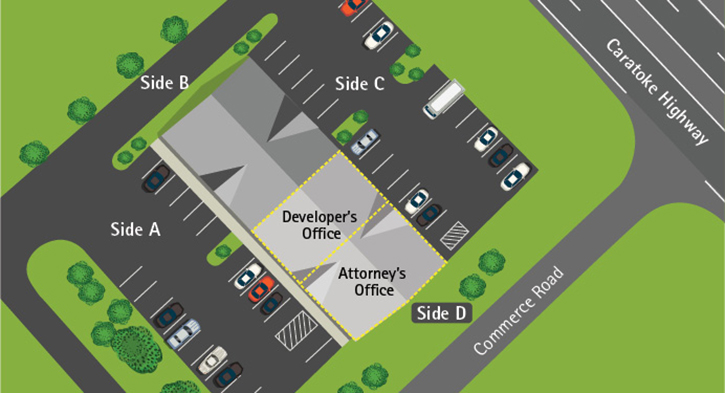
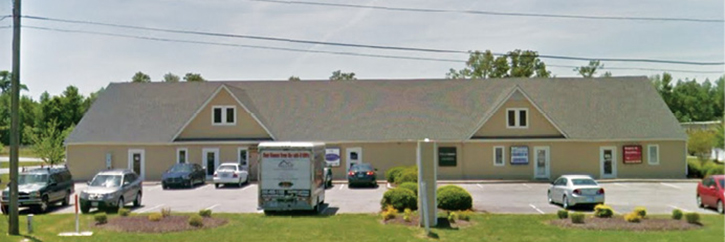 (Photo by Google Street View; all other photos courtesy of author unless otherwise noted.)” />
(Photo by Google Street View; all other photos courtesy of author unless otherwise noted.)” />(1) The building as it was rebuilt afterward. The fire occurred in the occupancy on the right (the A/D corner) side of the building, only a couple of feet away from the occupancy to the left whose tenant ran in to retrieve computer hard drives. (Photo by Google Street View; all other photos courtesy of author unless otherwise noted.)
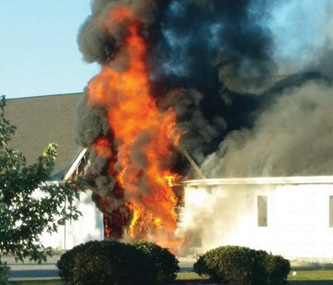
(2) The fire before fire department arrival. Bystanders reported that a truck had crashed into the building, but there was no indication that a truck was inside and there were no skid marks or other indications of an accident. (Photo by Robert Farthing, courtesy of The Outer Banks Voice.)
I immediately met a probationary firefighter who had arrived in his own vehicle. Fortunately, this young man had his gear on and was ready to help, although he was not released to perform interior firefighting. I immediately told him to climb atop the apparatus and hit the volume of fire with the deck gun (photo 3). We still only had two personnel at this point. The engine was a 1991 pumper equipped with a 1,000-gallon water tank and a 1,250-gpm pump, so I figured we could get a decent knockdown on the main body of fire and I would have time to deploy a five-inch hose section and connect to our water source. When all else was chaos, the transition to incoming water supply was flawless. We now had incoming water from a reliable hydrant in the same parking lot.
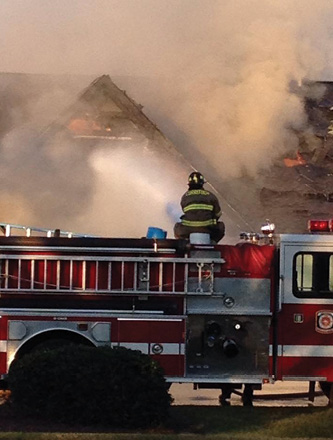
(3) One of the first two firefighters to arrive on scene used the deck gun on this platform, the initial attack piece, to knock down a large portion of fire; it would quickly flare back up again.
As I was finishing up the transition, a truck came flying up into the scene (something we have all seen before) pulling a 20-foot gooseneck trailer stacked with several dozen hay bales. Since this is farm country, it is not surprising, but I thought, “Does this guy realize he’s 50 feet away from this ripping fire with a Paul Bunyan-sized matchstick?” I start immediately yelling at the driver to move this rig!
The sheriff’s department had not yet arrived to secure the scene, and the driver jumped out of his truck, went into the office adjacent to the fire occupancy, and emerged with two computer towers. He was a local land developer; when he came out, several words were exchanged, and he finally moved his truck and trailer away from the building. We have since become friends and we laugh now about the crazy guy driving up to this inferno with his trailer of fuel.
Never underestimate the oath we take to protect property, too. For this occupant, these hard drives held years of building plans and documents; to lose them would mean losing everything.
Adding to the confusion, two bystanders informed me that a truck loaded with hay bales had driven into the building. I thought they must be mistaken as I thought we just rectified that situation. But I noted the information and filed away in my mind.
Master Stream Ineffective
Although the master stream was putting out fire, it was just not extinguishing as a master stream should. Clearly, we had some fuel involved, but what? Initial reports said the driver was in a pickup; at this point, I was still thinking maybe he had a medical emergency or something and that this was just an accident. I was shaken from my thoughts by an inexperienced junior officer breaking full-length windows and doors to the fire occupancy with a halligan.
So, we had no fire control, mass confusion, and this firefighter was doing what inexperienced members do best—breaking glass, creating uncoordinated horizontal ventilation, and opening up a major fire flow path. We had four members on scene, plus a paramedic (who didn’t have turnout gear) and this freelancer! I immediately grabbed this member and pulled him back to the truck. He gaves me a two-minute argument about what he was doing. Luckily, a volunteer chief officer showed up, quickly asked me to take this junior officer and one other firefighter, make a push into the adjacent office (the land developer’s), and see what we had. I was relieved to be relieved and let him take over as incident commander (IC). We made entry and met light to moderate smoke but not enough to force us to our knees; visibility was still decent. We located the adjoining wall to the fire occupancy and used the thermal imaging camera (TIC) to determine that the truck was just on the other side.
Tensions were high, and I ordered the firefighters to begin breaching the wall to rescue the driver. We had confirmed reports early on that the driver had never been seen exiting the vehicle or the structure. This was our chance: We were a small-town volunteer department, and we were about to make a grab. One crew member got a few good chops in the wallboard, and we started getting smoke return.
“Something Isn’t Right!”
If he’s been firefighting long enough, any good firefighter knows to respect his sixth sense. I had a feeling strong enough to give me a chill underneath my gear. We were next to this raging fire, with all our gear on, trying to chop through a wall, and I had a chill? STOP. Something wassn’t right. I stopped both men with me. They were angry! “He’s right there; we can get to him!” I was torn, but my gut told me something wasn’t right. I gave the order to back out and pulled everyone out. The thought quickly crossed my mind, “What if this is someone who doesn’t want to be saved?” I had never considered that a possibility until then. Call it divine intervention, call it whatever you want, but I believe God was looking down on us and gave me that feeling. I still can’t explain it.
We regrouped on the C side of the building and gave our report to the deputy chief now in command; he informed me that bystanders witnessed a man light his truck on fire and drive into the building. Maybe I was onto something inside. Our 75-foot quint arrived, and I helped the operator quickly put it up and into place, pushing an elevated master stream into the main body of fire and pushing away from the B-side exposure occupancy (photo 4).
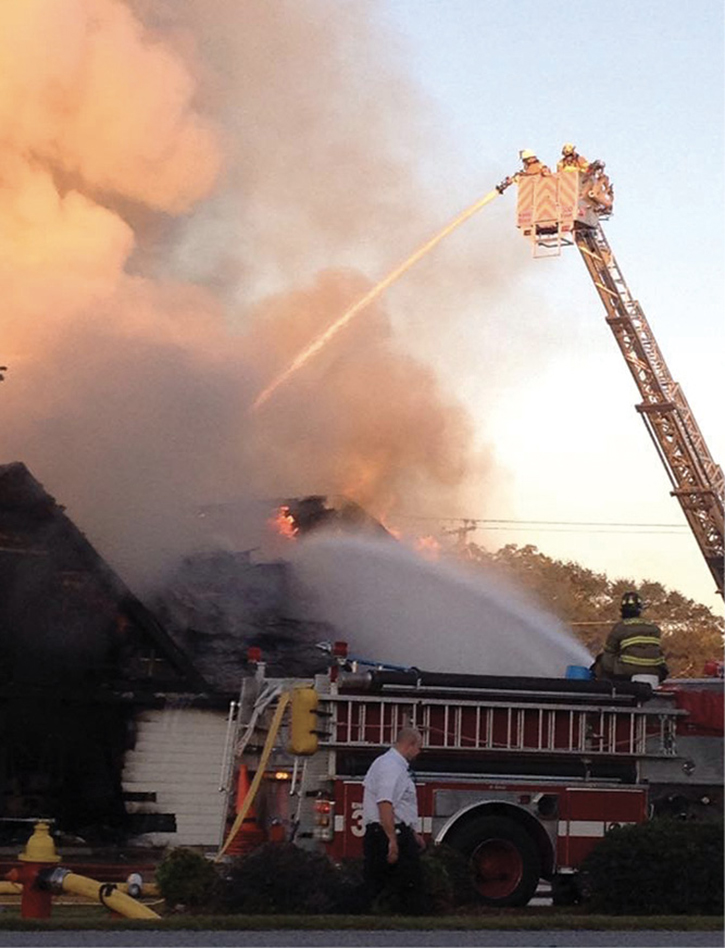
(4) The 75-foot quint put an elevated master stream into the main body of fire, pushing away from the B side exposure occupancy.
The IC reassigned me to Division B and agreed with pulling everyone out for defensive operations until backup arrived. The second-due volunteers arrived with a myriad of personnel and equipment, a couple of engines, a tanker, and a 100-foot platform. They arrived about the same time as the city firefighters. The volunteer platform tagged the secondary water source on the structure’s B side. Since both hydrants were on the same loop, it severely limited our water flow capabilities. The city firefighters regrouped and prepared to make a push back inside. We began to gain ground on the fire and the decision was made to go back into the D exposure attic space and see if we could get a stop on the fire. So far as we knew, the structure was a strip mall with four or five office spaces with a common attic. The mutual-aid platform set up an elevated master stream and began flowing water into the structure’s self-vented roof. This master stream was pushing from the fire occupancy inward toward the exposure, and the crew was advised to use caution and avoid flowing onto what we thought were fire breaks in the attic. We later found out that this building was not rated for fire breaks in the attic and a single sheet of drywall was what held the fire in place. We had to take care not to punch a hole through the drywall and open the wall up.
City firefighters and I integrated on the A side; using TICs, we confirmed that there was an occupant still inside the vehicle but the conditions were not compatible with survival.
We reevaluated the conditions several times and, for some reason, the area around the pickup truck could not be extinguished. A couple of hours in, it was decided to transition to foam solution for extinguishment. Although the foam began to make a positive change, it did not do so nearly as quickly as it should have. Eventually, the fire was extinguished, and we began overhaul on the area immediately around the truck, being careful to try to preserve evidence (photo 5). Roughly eight hours after the incident had begun, it was turned over to the local sheriff’s department, which handles arson investigations. The sheriff’s department contacted the North Carolina Bureau of Investigation and the Bureau of Alcohol, Tobacco, Firearms, and Explosives, the agencies that handle arson investigations in the state.

5) The A side of the structure after the fire was knocked down; the A/D corner is to the right.
Investigation
Based on eyewitness reports, bank security camera footage, and other information, this had been a deliberate act, not an accident. The suspect was embroiled in a legal battle with this attorney’s office and apparently felt it had wronged him. He waited until after closing hours so as not to harm anyone but himself.
His truck was filled with 30 gallons of gas in several cans and with 10 gallons of gas in the cab of the truck, propane cylinders with road flares taped to them, and hay bales doused in gasoline. He also had a homemade improvised explosive device in the front seat in a gym bag and a revolver in his lap. In an act of domestic terrorism, he lit his vehicle on fire and drove it into the building (photo 6). The homemade explosive failed to detonate.

(6) The vehicle was a late model Chevrolet Silverado, which was completely obscured on arrival. At this point, the event’s magnitude was still relatively unknown until fire crews were called to stand by while the explosive ordnance disposal robot removed ordnance.
I still shudder to think of what we might have faced completing the breach of the wall. Would he have shot me and my men? Would the explosive device have gone off if inadvertently jostled as we attempted a rescue? Would a propane cylinder have exploded, injuring or killing one of us? To this day, I can’t explain my actions or the feeling that overcame me, but I believe wholeheartedly that it may have saved our lives that day.
Trust your gut. Listen to what you are feeling inside. Put your firefighters first. Make solid decisions and stand by them, even if they are unpopular at the time. You have a duty as an officer or a senior member to bring your people home. We may not be excited about taking annual antiterrorism training, thinking, “It’ll never happen here.” But we just don’t know. It CAN happen anywhere.
THOMAS W. CASTELLOW is a captain and NREMT-P with Navy Region Mid-Atlantic Fire and Emergency Services and a volunteer firefighter and former deputy chief in Moyock, North Carolina. He has more than 14 years of experience in public safety and has a bachelor’s degree in fire administration and an associate degree in fire science from Columbia Southern University. He is a member of the North Carolina State Fireman’s Association as well as the International Association of Fire Fighters.

